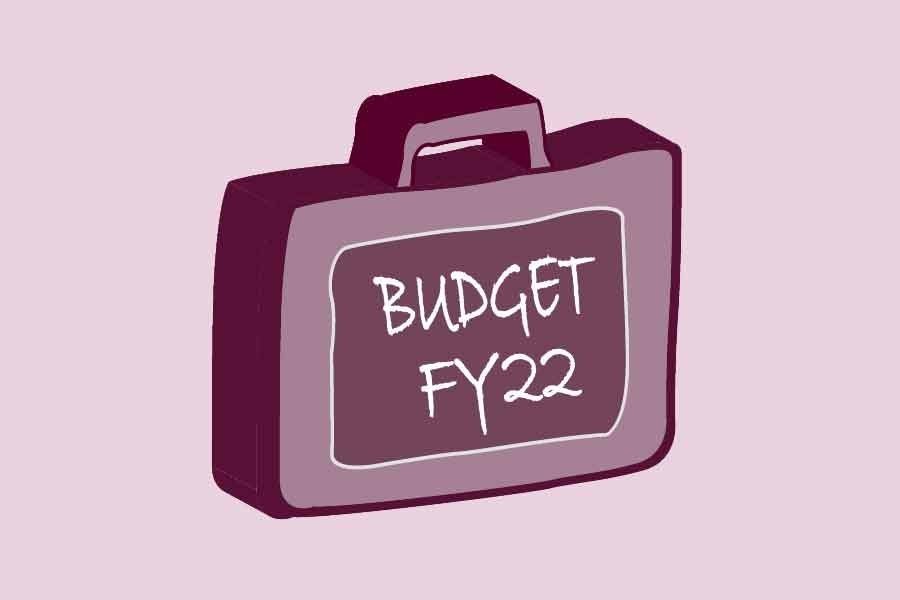The nation this year is celebrating the golden jubilee of its independence. And the proposed national budget for the fiscal year 2021-22 (FY22) is one of many events to mark the year-long celebration. It is the 50th annual national budget. Finance Minister AHM Mustafa Kamal presented the budget on Thursday at the Jatiya Sangsad (national assembly). Though presented under the shadow of the year-long pandemic, this is remarkable for a historical record.
It was late Tajuddin Ahmad, the then finance and planning minister of newly independent Bangladesh, who placed the first national budget of Bangladesh on June 30, 1972. The original outlay of budget for FY1972-73 was Tk 786 crore or Tk 7.86 billion. Of the amount, Tk 5.01 billion was for the annual development programme (ADP). The outlay of the country's 50th budget stands at Tk 6.03 trillion. Thus, in the past 50 years, the size of Bangladesh budget increased by around 700 times. So far, 12 finance ministers and advisers have presented the national budgets over the long 50 years. AMA Muhith and late M Saifur Rahman placed 12 budgets each. During these five decades, the Bangladesh economy has achieved a lot by overcoming many hurdles. At the same time, the ultimate goal of attaining a poverty-free and just society still remains a distant dream.
The budgets in the early years were guided by socialist principle and primarily focused on rebuilding of the war-ravaged country. A shift from a socialist approach to a mixed economy started in the mid-70s. It was mainly due to a sudden political changeover in 1975 when Bangabandhu was murdered. A gradual shift from the socialistic path was marked by the introduction of a regime of mixed-economy. However, it did not continue for long. Instead, an approach to promote the private sector became more evident. A series of structural, sectoral and institutional reforms, strongly backed by the World Bank and the International Monetary Fund (IMF), dominated the budgetary process in the 1980s and 1990s. Transition to a democratic regime from a decade-long autocratic rule in 1991 opened up a new window of opportunities to move ahead. The elected governments in the next decades embraced the philosophy of a free-market economy. Budgets of the following years were formulated accordingly. For the last decade, the annual budgets were prepared under the framework of the Five-Year Plan (FYP).
In this connection, the proposed budget for FY22 has also been the second budget under the 8th Five-Year Plan (8FYP) framework, which has stressed transparency in the budget preparation process. It has pointed out that the 'budget process is still on a yearly cycle' and so 'expenses do not carry over to the next fiscal year causing an end-year spending bulge.' It has also mentioned that the link between the development budget and revenue budget is still weak. The planning document has advised the government to make the pre-budget statement available in the public domain. The objective is to improve the level of transparency and participation of key stakeholders. The government made no such statement in the past year or the current year.
The plan has also said that the government would make efforts to address the existing shortcomings of the budget. In this connection, the plan has clearly mentioned that the 'progress in this specific dimension will be tracked through Bangladesh's overall performance in the Open Budget Index.'
The index is usually produced by the Open Budget Survey, a global monitoring mechanism of nations' budgets. The index uses some 100 indicators to assess whether the governments put eight important budget documents in the public domain in a useful and comprehensive manner. The plan has also expressed optimism that the government would make available all fiscal data showing actual outcomes for both expenditures and revenues.
It is to be noted that in the latest index, released last year, the budget transparency score of Bangladesh was 36 out of 100. The country also ranked 79 among 117 countries in terms of budget openness. In South Asia, only Pakistan trailed behind Bangladesh regarding budget transparency. The country report also mentioned that 'Bangladesh has decreased the availability of budget information by failing to publish the year-end report online in a timely manner.'
During the 8FYP period, it is also expected that sector strategy papers (SSPs) and multi-year public investment programme (MYPIP) will be introduced. These will be used in the medium-term budgetary framework (MTBF), annual development programme (ADP), and revised-ADP (RADP) processes in the two pilot sectors initially. These will be rolled out to all other sectors gradually. Again, no such things are visible in the current year.
The finance minister, in his budget speech on Thursday, did not refer to the priorities set in the 8FYP on budget transparency. In the past budget speeches, the same thing happened. There was also very little reference to the 8FYP or the guidelines mentioned thereof. He, however, said: "We have already begun implementing the 8th Five Year Plan. Therefore, its implementation will get special importance in this budget."
Despite all odds, the budget for FY22 remains a matter of celebration. The finance minister, however, missed an opportunity to celebrate it in a more meaningful manner. It was expected that he would introduce a new trend of pre-noon placement of the budget in parliament by abandoning the colonial tradition of after-noon presentation. By so doing, the minister and also the government could have given the media, the economists and all other stakeholders a bit of extra time to review the budget documents on the budget-presentation day.


